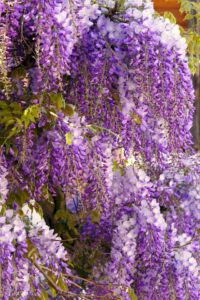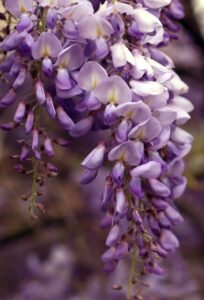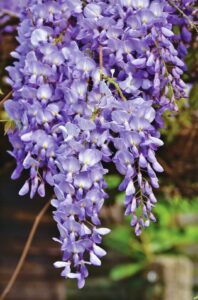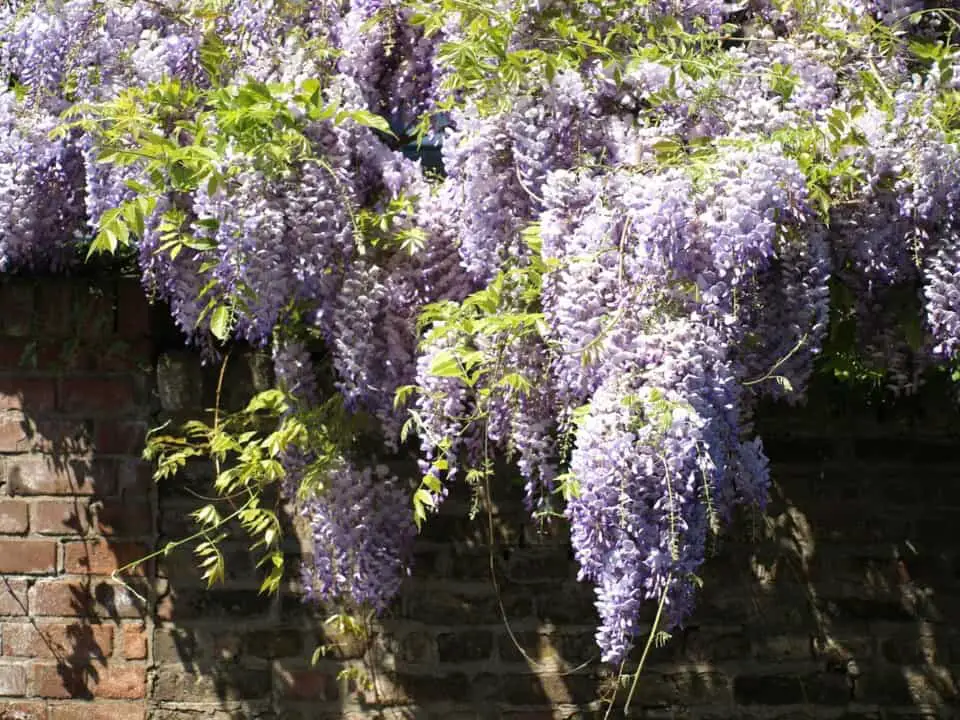Some links in the post are affiliate links and I get a commission from purchases made through some links found in the post.
The lovely Wisteria has its origins in many countries, namely Japan, China, Korea, Southern Canada, and the Eastern USA. You will also find this plant in France and Germany as well as other parts of Europe.
You will find this wonderful plant cascading it flowers in the late spring. Because it is a vigorous grower it needs regular pruning, but with the right care and attention you will be rewarded with a magnificent display.
An interesting fact about the different types of Wisteria is that the Wisteria Floribunda, which comes from Japan tends to twine clockwise, while the Wisteria Sinensis which stems from China will twine clockwise.
This is the more vigorous grower of the two types. The question which many people ask is how long Wisteria blooms for because we want to enjoy it for as long as possible.
There are some reasons why your vine may simply not flower at all for the season but once we know the reason for the lack of blooms we can enjoy the beauty of the Wisteria again.
The trick with Wisteria is not to get the plant to grow – they are vigorous climbers – but to get it to flower.
Compared to many other plants Wisteria is a relatively late bloomer which gives us less time to enjoy it than many other plants.
There are some things we can do to lengthen the blooming time and it is well worth bearing these tips in mind.
How Long does Wisteria Bloom For?
Normally a Wisteria will flower between April and June. Sometimes there will be a second show of flowers in August although this does not happen every year. The wisteria will usually bloom over a 4 – 5 week period.
How to get your Wisteria to Bloom for Longer
 Some of the most common reasons why the Wisteria does not bloom or seems to only bloom for a short while is due to incorrect pruning. In fact, pruning Wisteria is considered the key to consistent flowering.
Some of the most common reasons why the Wisteria does not bloom or seems to only bloom for a short while is due to incorrect pruning. In fact, pruning Wisteria is considered the key to consistent flowering.
Because Wisteria is a vigorous grower it will require pruning twice a year in Summer and Winter. As the plant grows upwards along pergolas and frames this means having long ladders at hand to prune it.
Even vigorous pruning will send it into a growth period so you should make sure that you plant your new Wisteria in a place where it can spread outwards and upwards.
Wisteria also does not enjoy being moved and you will find if you decide to transplant it elsewhere that roots still come up and will be hard to remove completely.
It is also worth remembering that if Wisteria is planted in a place where it is happy, it will do well. South and west-facing spots are ideal.
Also, it is worth remembering that your Wisteria may not bloom in the first to years after you have planted it, but by the third year it will be ready to bloom prolifically.
Make sure to give it a decent amount of water in the dry periods when you first plant it.
There are other reasons why your Wisteria does not bloom for a long period:
- Too much shade
- Soil which is too fertile – yes, you read this correctly!
- Lack of pruning
- Sparrows eating the blooms
- A poor plant
Wisteria very seldom requires any extra feeding. Being a member of the legume family, this plant develops its own nitrogen, so it does not need fertilizing like other plants do.
Sparrows enjoy eating the small buds on the Wisteria but normally there are plenty to go around and still have a full bloom.
There are in truth only two main points to ensure your Wisteria blooms well, namely:
- Buy a plant that is in bloom so you know it can bloom
- Prune it twice a year
A note about buying a new Wisteria for your garden
Start by buying a plant which already has some blooms on it. This is so that you know for sure that the plant can bloom.
While growing from seed is cheaper, it takes a lot more time to grow an established plant from seed.
A good plant dealer will tell you that Wisteria grows and blooms best if it is a grafted plant. You will know it is grafted by the slight bulge which will be clearly visible in the stem just above the soil line.
Decide on where to plant your Wisteria, pop it in, give it a good drink to ensure it does not dry out. Once established, leave it alone and enjoy the blooms.
It will take care of itself. Wisteria can even cope with drought conditions although heavy frost may damage any buds.
It is not the best thing to keep your Wisteria in a pot as they tend not to bloom very well if their growth is constricted. Rather, remove it and plant it in a sunny spot and you will be rewarded the following spring with colour.
You may also like: The common problems with a wisteria & how to fix them
How Many Times a Year does Wisteria Bloom?

This magnificent plant is most often seen blooming in purple, in fact, this is the colour that graces most photographs that you see of Wisteria as a pergola cover.
Normally once the plant is established it will only bloom once a year. However, there are some cultivars which will bloom twice and even three times a year. Cultivars of Kentucky and American Wisteria can expect to see this.
American Wisteria will bloom at the start of June and carry on through August. Kentucky Wisteria will start to bloom in the early summer at the end of June and can bloom three times each year.
Japanese and Chinese Wisteria will start to bloom earlier in April and may not bloom again.
Will Wisteria Bloom Every Year?
Wisteria is one of those plants that once established, we can almost guarantee that it will bloom every year.
Possibly one reason for it not to bloom is frost damage, in which case you may want to think about moving it to a sheltered spot or protecting it to minimise the damage.
You may also like: Why are your wisteria leaves turning yellow
How Long Does it take Wisteria to Mature Before it Starts to Bloom?
Wisteria is regarded as a vigorous grower but is slow to mature. It may not even bloom for three to five years after you have planted it. However, once it has settled and is established there is very little to stop this rampant plant.
Wisteria can easily grow 10’ or more during the growth season and it is great if you fancy it as a pergola or fence covering.
What Colours are Wisteria when in Bloom?
There are several other colours which you can choose from. You may find Wisteria blooming in shades of pink, blue and white.
A note: If you think you have seen Wisteria blooming in yellow, you are most likely looking at Laburnum. Wisteria does not bloom in yellow.
You may also like: 6 great benefits of owning a wisteria
What does Wisteria look like When not in Bloom?
After your Wisteria has flowered you will be left with brown bean-like pods which will hang on the plant until the winter season starts.
Because Wisteria is a deciduous plant it does not stay green during the cold months of winter. The leaves will change back to green in the spring. Occasionally some varieties will bloom before losing their leaves, which turn gold or yellow first.
A few general notes about Wisteria blooming
If possible you should avoid buying Wisteria which has been grown from seeds. This is because the plants remain in a young state for many years. In fact, a plant grown from seed can take up to 15 years to bloom!
Best to start with plants that have been grafted or propagated from cuttings. Choose a reliable garden centre as they will either have them or be able to order them for you.
Never overwater your Wisteria and resist the temptation to fertilize the plants. A certain amount of stress is needed for the Wisteria to force the new buds to develop.
High nitrogen fertilizers will spur on leaf production at the expense of the flowers.
Wisteria which is planted in part shade will never bloom as well as the plant which is set in full sun. Plants in full sun will bloom more reliably than those in dapple conditions.
Aim for at least six hours of direct sun light per day, any less and your plant will not bloom as prolifically as you would like.
You may also like: Wisteria vs lilac
Final Thoughts
 Wisteria is a fragrant plant which flowers in the spring and is classed as moderately easy to grow.
Wisteria is a fragrant plant which flowers in the spring and is classed as moderately easy to grow.
It is best planted either in spring or autumn and will thrive on south and west-facing walls.
Once it is established it ill need to be pruned twice a year to encourage blooming and to keep it under control as it tends to grow rapidly.
So, if you think you have the time and motivation to add Wisteria to your garden, rest assured that you will be rewarded year after year with the most magnificent display or blooms.
You may also like: Wisteria tree vs vine


